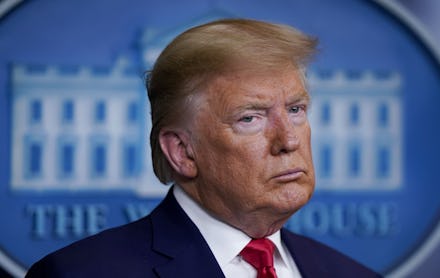Twitter debuted its new "manipulated media" label on a video Trump retweeted

From winding, misspelled rants to sharing straight up misinformation, President Trump is infamous for his Twitter use. The platform has faced criticism for allowing Trump's tweets to go unchecked. But over the weekend, Twitter used its "manipulated media" label on a video shared by Trump, marking the first time the platform has ever pulled it out.
Last October, Twitter announced its intentions to tackle manipulated media. After sharing an initial draft of the policy for public input, the platform introduced a finalized version last month. Twitter stated that it would apply the label to any media that was "significantly and deceptively altered or fabricated" to be misleading.
That applies to the video shared by Trump, which earned the dubious honor of debuting Twitter's new label Sunday. Originally tweeted by White House social media director Dan Scavino, the video shows former Vice President Joe Biden appearing to say, "Excuse me. We can only re-elect Donald Trump."
In his tweet, Scavino claims that the video came from a Biden rally in St. Louis, Missouri. According to CNN, that's not even true. The clip itself is from a speech in Kansas City, Missouri, and what Biden actually said was, "Excuse me. We can only re-elect Donald Trump if in fact we get engaged in this circular firing squad here. It's gotta be a positive campaign."
The manipulated media label started popping up Sunday. It doesn't seem to be visible to every single user, though, which poses questions about how effective it is. Still, the label has invoked responses from not only Scavino — who tweeted that the video was not manipulated — but FCC Commissioner Brendan Carr.
In a tweet, Carr wrote, "We're seeing an intentional and coordinated effort by established gatekeepers to equate political speech they don’t like with the entirely separate categories of doctored deep fakes, illegal content, and deceptive cheap fakes." FCC commissioners are appointed by the president.
There are a few issues with Carr's statement. To start, it's true that Scavino's video wouldn't fall under the category of anything like a deepfake. However, Twitter's policy isn't limited to deepfakes and isn't equating anything to them. It simply applies to any manipulated video. Cutting out portions of someone's speech to make it appear as if they're endorsing a political candidate and sharing without context is manipulation.
In addition, this isn't a case of "established gatekeepers" not liking political speech. By many accounts, Twitter has actually slacked off when it comes to Trump. So far, Trump has made over 16,000 false or misleading claims during his presidency, and many of these lies have occurred on Twitter.
For example, in January 2017, Trump blamed Delta's computer outage, protesters, and the "tears of Senator [Chuck] Schumer" for problems at airports. However, BuzzFeed News reported that it was Trump's own travel ban that was responsible for delays, as officials struggled to interpret the executive order. Or take March 2017, when Trump falsely claimed that former President Barack Obama had bugged Trump Tower. Not only was there no evidence at the time, but Trump still hasn't been able to produce any proof of his predecessor's alleged wiretapping.
This isn't even Trump's first time sharing a questionable video. Again in 2017, Trump retweeted three Islamophobic videos from Britain First, a far-right hate group in the United Kingdom. Last April, Trump joined in on harassment of Rep. Ilhan Omar (D-Minn.), tweeting a video of one of her speeches intercut with footage from the Sept. 11 attacks. Omar later said that Trump's actions led to an increase in death threats.
Trump's lies on Twitter precede his presidency, but they became especially dangerous after he took office. Twitter has allowed Trump to get away with a lot. While it is good to see the platform cracking down on a video that he shared, it's unclear whether Twitter will start to actively label the president's own tweets when they're verifiably false.